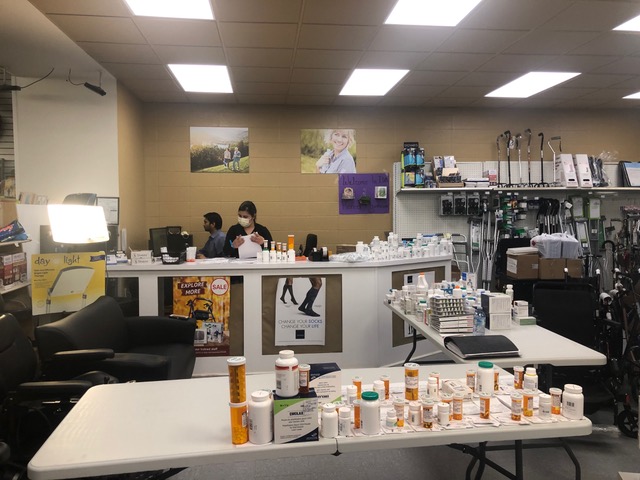
Pharmacists across Alberta have tweaked procedures to protect themselves and their patients throughout the COVID-19 pandemic.
Jordan Maskell, RhPAP’s High Level-based freelance writer, spoke to pharmacists in four rural Alberta communities to learn how the pandemic has affected the way they meet the needs of their clients in both the community and hospitals.
Protection
After a hectic first few weeks following the pandemic outbreak, Rocky Mountain House Primary Care Network and Shoppers Drug Mart pharmacist, Sagar Vakil, says his pharmacy has geared up to combat the threat of contagion.
“In the first couple weeks, we could only protect ourselves by doing two meters of physical distancing. People were scared and were panic buying, so the pharmacy was extremely busy,” Vakil explains. “As the pandemic continued, we got glass shields and surgical masks, which we used while providing services to the patients.”
According to Jan Welke, owner of High Level IDA and Pioneer Pharmasave in Fort Vermilion, wearing some kind of covering like a paper surgical mask or N95 mask will lessen the spread of respiratory particles if you have COVID-19.
“We are also using lightweight face shields as well because some people can’t work with masks on. It fogs up their glasses or they get an irritation from it, so wearing clear face shields without a mask is the same thing,” says Welke.
A big change for pharmacy staff is that they are now required to wear personal protective equipment (PPEs) when they are in the direct patient care areas, adds Kaitlin Rafuse, a pharmacist at the Northwest Health Centre in High Level.
“We have strict hand-washing [requirements], but we don’t have to glove up or put on eye protection unless we are in direct contact with a patient with possible COVID-related symptoms.”
We had a lot of patients who were out of medication, couldn’t see a doctor, or had mild ailments. We had to deal with it, because there wasn’t an avenue where they could see a doctor or it was a minor thing and wasn’t worth sending them to the hospital.
– Mike Song
Pharmacy resources/education
Another change from the pre-COVID environment is that pharmacists are now required to move beyond their traditional roles of dispensing medications, and concentrate more on providing patient care services.
“A lot of doctors’ offices were closed, so pharmacists had to step in and fill the gaps,” explains Peace River pharmacist Mike Song. “We had a lot of patients who were out of medication, couldn’t see a doctor, or had mild ailments. We had to deal with it, because there wasn’t an avenue where they could see a doctor or it was a minor thing and wasn’t worth sending them to the hospital.”
While pharmacists’ face-to face interactions were generally with people who are stable and at home, Rafuse’s role inside the community health centre means she has been collaborating with physicians to deal with patients who have acute medical problems.
“My position is strictly clinical, so my responsibility is to see all the patients admitted in the hospital and collaborate with them and our team to figure out what the best thing would be for that patient,” she explains, adding that, within the hospital, pharmacy assistants and technicians are responsible for the distribution of medication.
Vakil has visited the hospital once to see a patient who required diabetic education to start using insulin, but has been able to manage his other diabetic, anticoagulation, and smoking cessation patients via phone appointments.
“I was only seeing patients who absolutely required face-to-face meetings, which was insulin starts and other diabetic injectable starts [and dose management],” said Vakil. “As the pandemic continues, we are thinking of doing virtual care with the patients. It is currently in the initial phases where staff is getting trained and obtaining consent from patients before we go live.”
